Email marketing enables brands to contact prospective customers regularly and create trusting relationships.
The problem is that recipients are bombarded with hundreds of emails. On top of that, crafting engaging emails can be challenging. That’s where pre-made email marketing templates come into play to take some of the load off.
This guide will cover email marketing templates, their main components, and the best practices and examples to help you make the most out of them.
What is an email marketing template?
An email marketing template is an email with specific structures that you can tailor to your needs. Instead of creating an email from scratch, email templates serve as a starting point to help you customize emails with the branding elements of your choice.
Email templates help you establish an effective communication channel between your brand and subscribers, which you can use to your advantage for a range of purposes:
- Sharing important company updates
- Increasing revenue with upselling or retargeting opportunities
- Improving customer experience with feedback emails
- Sending seasonal emails for targeted offers
- Rewarding engaged customers with loyalty programs
Some marketers are under the mistaken belief that only large corporations can benefit from pre-designed email templates because enterprises have both the resources and design skills required. But that’s far from true. You can choose between several affordable and user-friendly email template builders that give you access to a large library for every occasion.
Once you select the templates, all it takes is dragging and dropping content blocks, adding copy or visual elements, and scheduling your email. In fact, anyone on your team can do it. Even if you have zero coding skills or don’t want to use them for small business email marketing, you can turn templates into high-quality emails in a few minutes without spending a fortune.
What’s more, email template builders offer templates with responsive designs that work on any device. That way, subscribers can read your messages no matter their device. For all these reasons, email marketing templates save you time, money, and effort while optimizing the experience for your subscribers.
Email templates have a structured layout that lets you focus on the right elements and tailor them to each recipient’s preferences.
Let’s break down the “right elements” part.
What are the main components of an email marketing template?
Email marketing templates are the foundation of your email strategy, on top of which you start building your message. So what key components should you include to make a solid structure out of them?
Subject line
Creating compelling email subject lines increases the chances that your recipients will open your email. You don’t want to end up in the spam folder.
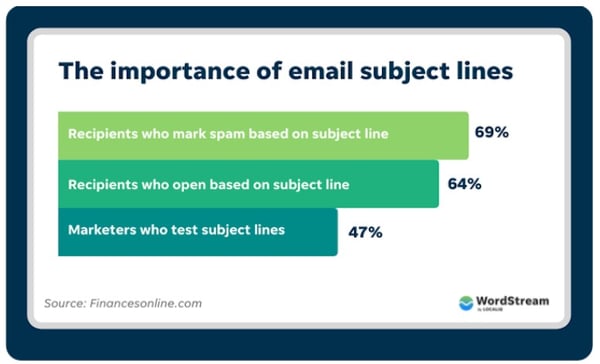
Source: WordStream
You need to perform A/B testing for your subject lines to find out what resonates with your audience. However, some consistent rules can guide you on how to make them work.
- Get to the point. Your email recipients hate losing time reading lengthy descriptions. Use actionable language to help them act on your message.
- Make them short. The ideal length is between 40-50 characters so readers aren’t tired out, and important information doesn’t get cut off on mobile devices.
- Show value. Recipients want to know beforehand the value of your email and how it addresses their challenges.
- Avoid spam triggers. Stay away from practices like using too many special characters, all-caps copy, or spam-triggering phrases like “click here.”
- Personalize. Subject lines should include personalized elements so that readers see you understand their unique needs.
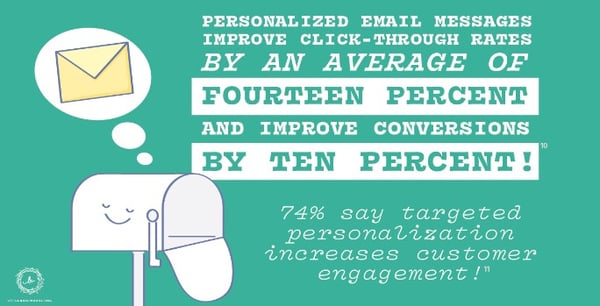
Source: LBM
Body copy
A great subject line impacts your open rates, and your email content affects your click-through rates. So let’s talk about how you can keep email recipients scrolling.
First and foremost, your readers shouldn’t have to dig through every detail to get to your key message. Tie your copywriting to your value proposition and the benefits it brings. Emphasize your offer by including statistics, from helpful tips to educational content. Not every email template element is about selling, right?
Enforcing a concise approach to email copy is at the heart of email marketing. Brief and concise copy works because it shows you value recipients’ time. Stay away from dense descriptions that overwhelm readers. Use short blocks of text with bulleted lists to help them focus on your call to action.
Last but not least, create timely content; circumstances always matter. Invest in dispatching content like last-minute tips or gift guides and announcing holiday sales. It’s crucial that your brand stays connected with the holiday spirit!
Call to action
Every email template you distribute has a unique objective. That is what your email call to action (CTA) is for, as it is the most important tool for turning clicks into conversions.
Your CTA is the logical step recipients need to take after reading your value proposition. Therefore, you have to make it clear and prominent. You don’t want them to scroll past your CTA, so place it strategically and make it stand out.
Use bold colors and action-oriented language. Consider placing it above the fold to catch attention. Anything goes as long as it appears as a natural part of your email.
We can’t give you there’s a magic formula for the number of CTAs you should use. You might add more than one to increase the chances of readers clicking through and taking action. But whatever you do, make sure to direct them to a single action to avoid confusing them regarding the next step.
Links
Your email links are like an extension of your call to action. Before including links within your email template, consider these questions. Where do you want to direct your email recipients once they click on them? When they land there, what do you want them to do?
Answering these questions is key to determining which links serve your objectives and how to guide readers toward the desired action. It’s important not to clutter emails with unnecessary links since it will probably distract them from converting.
Your links should be descriptive and lead readers to the proper page. The last thing you want is for your links to have typos or direct users to a weird site.
When you include links in a pre-made email template, focus on offering true value. Link to content that educates readers, addresses their pain points, or highlights an offer. Use short phrasing so all device users can easily view and click your links. Also, white space will clarify your email design and make it easier to tap links with a finger.
Email links usually serve specific actions like promoting products or announcing events. But whether we like it or not, the unsubscribe link is lurking at the bottom of the page.
First, not including such a link gets you into legal trouble since it’s against the Controlling the Assault of Non-Solicited Pornography and Marketing (CAN-SPAM) laws. It should be visible because if readers can’t find it, they may mark your email as spam and damage your sender’s reputation.
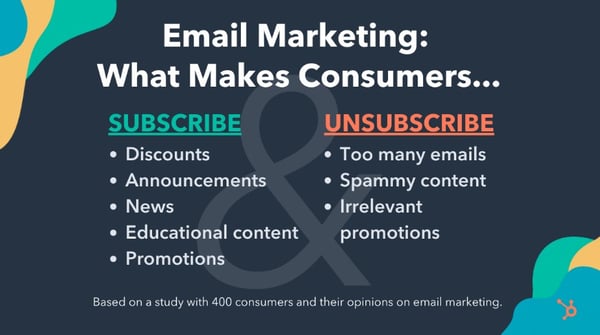
Source: HubSpot
People on your list who aren’t really interested in your company’s news shouldn’t be there in the first place. They probably won’t convert to leads and will affect the accuracy of important metrics. But nobody in marketing is okay with prospects unsubscribing, so how do you save the day? Build creative unsubscribe pages that make them think twice about opting out.
Images
Words are everything. But there’s no better way to support them than with images. Besides catching attention, your email templates’ images emphasize the point your copy makes.
But generic stock images that don’t represent your brand won’t serve your objectives. Besides your logo, every email image should be relevant to your overall branding. Your images should align with your unique value proposition and complement the email copy.
It’s equally important to ensure images are properly displayed on different email platforms and devices with the analytic options provided by your email marketing tool. And don’t neglect to consider the image size and usage of multiple images since these practices affect your email loading time.
Social media sharing components
Many marketers underestimate the value of adding social media sharing components to their email templates. But the truth is that if you don’t include these options in your emails, you’re just leaving money in your outbox.
When you add social sharing elements to your emails, you increase visibility for your promotions and expand your reach. You can generate new leads by encouraging readers to share your email material without spending extra time or resources. Your email marketing content and current recipients do the hard work for you!
So the least you can do is facilitate the sharing process. That includes creating visible social media sharing buttons or links that recipients see immediately. It’s a good practice to include different options, seeing that not all audience groups have the same favorite social media channels. However, understanding your customer profile will help you focus on the most profitable network for your business.
Best practices for building effective email marketing templates
Building effective email templates comes down to selecting the best ones and then getting your creative juices flowing. We’ve got some guidelines that will prompt clicks and conversions. Keep reading to learn the best practices for crafting engaging email templates.
1. Identify your goal
Enriching a pre-made email template makes no sense if you don’t set a goal first. What are you trying to accomplish? Is it generating new leads? Do you wish to build brand awareness or educate your email recipients? Or do you want to announce a product launch?
Identifying the goal of your email marketing template should never come as an afterthought. It determines the elements you put in your email and how you’ll match them to your subscribers’ needs. Setting clear objectives lets you plan everything beforehand. Not only do you set a clear path toward success, but you make measuring your email performance easier.
2. Highlight your brand elements
You might impress email recipients with a visually appealing email template. But what good will it do if they can’t link it to your brand? Adding identifiable brand elements to your email templates helps readers recognize your brand assets – and, more importantly – your emails.
How can you create a strong and recognizable brand identity for your emails? First and foremost, include your company logo in the header. In order to emphasize your branding, you also need to specify your brand colors, imagery, styles, and tone.
Consistency is vital for building customer loyalty, so don’t forget to use your brand elements across every marketing channel. That way, you increase prospects’ chances to notice and remember your brand.
3. Optimize for mobile devices
In 2023, optimizing your email marketing template to display flawlessly on every device is non-negotiable. While this parameter intimidates marketers, it’s not that hard to implement.
Most ready-made email templates are designed to adapt to different devices. Email optimization for every device goes beyond creating a readable email to making clickable elements large enough for people with small screens to tap.

Source: MarketSplash
Invest in responsive layouts customized to render perfectly on all devices. When it comes to mobile design, keep things simple and clear and avoid adding too many graphic components that slow down loading times.
Placing crucial stakeholders at the email top is a good practice, too, so readers on mobile devices don’t have to scroll through. On the other hand, desktop designs could include more graphic design elements since it won’t affect loading times or usability.
4. Consider CAN-SPAM regulations
The CAN-SPAM Act sets the rules for commercial emails, which apply to any business sending emails to promote products or services. But what does that mean in practice? Read up on some basic steps for ensuring your emails comply with CAN-SPAM laws.
- Avoid misleading subject lines. Your subject line should be indicative of the email content. Also, it’s better not to use clickbaity words just to make people open the email.
- Use correct sender information. Your email should accurately state the sender’s email address, the domain, and the name of the individual or company dispatching the email.
- Identify your email as an advertisement. CAN-SPAM laws insist that marketers disclose that their message is an advertisement. However, they offer flexibility regarding the way you present that info.
- Offer a clear unsubscribe option. This is probably the most important practice. Always include a visible unsubscribe option and make opting out straightforward and quick.
- Mention your company’s physical location. Every email you send should disclose your company’s valid postal address in the email footer.
5. Perform extensive tests
Test your emails before you send them out. After all, pre-made email templates are coded files with specific elements that may perform differently. To avoid issues with your structure, layout, or content, you must check your emails across multiple devices and different email clients.
Not only do extensive tests ensure you provide the best email experience, but they also offer valuable insights into what’s most effective. This type of data is your guide for what to keep and what to improve in future email marketing efforts.
The key variables you can test include subject lines, visuals, CTAs, overall content, and sending times.
6. Nail your timing
In email marketing, your timing matters. Even if your email content perfectly matches recipients’ needs, what happens when the timing or cadence doesn’t? Sending emails too often or too rarely directly affect key metrics. Note that a golden rule about timing doesn’t exist since the ideal frequency depends on your industry, email marketing template types, and business objectives. That’s why you need to explore email marketing calendar examples.
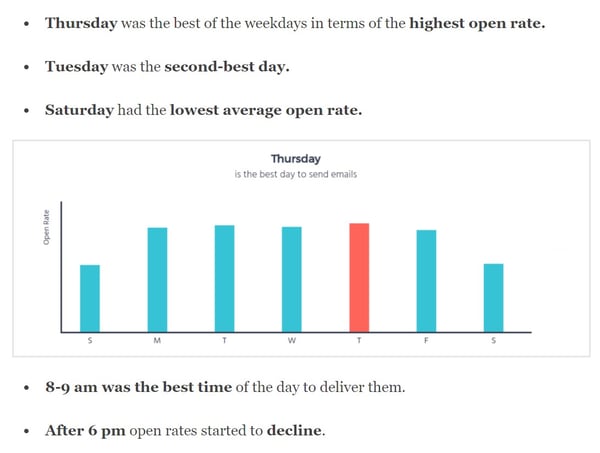
Source: Moosend
Again, performing A/B testing is essential to figuring it all out. We recommend you test everything out by sending emails at different times to see what resonates with your audience. Having valuable insight into your recipients’ email preferences also helps you find the sweet spot.
Suppose you don’t already have access to this kind of data. In that case, your emails should include an option for subscribers to adjust their email preferences or even a survey to fill in the necessary information.
7. Include alternative text for images
Most email marketing templates contain images, but sadly, not all of them have alternative texts. Features like spam filters or add blockers could prevent your images from loading on some servers.
Additionally, vision-impaired recipients use screen readers that rely on alt text to describe email images. In those cases, users cannot know what your image is about.
We live in an era when companies are finally understanding that designing for diversity is a professional – and ethical – necessity. There is no point in delivering a great email template if it provides a bad experience or makes recipients feel excluded from your content.
Write short and descriptive alt-texts for your images to showcase their purpose, make them accessible to all users, and avoid potential misinterpretations.
8 email marketing templates for business growth
You can find plenty of email marketing templates to use as your starting point. To spark your inspiration, we compiled a list of the best email templates for you to repurpose for driving business growth.
Welcome
Welcome email templates set the foundation for your relationship with recipients and frame future communications. Usually, prospects aren’t ready to do business at this point, so start by thanking them for subscribing and introducing your brand.
Welcome emails aren’t about pitching a sale but offering useful information about making the most of their subscription. However, offering a discount on their first order won’t do any harm. It’s actually one of the reasons why welcome emails perform better in terms of open rates.
Subject line: Hey, it’s Cayla & Lauren 👋🏼

Source: Really Good Emails
Knickey’s welcome email takes it one step further as the founders share their vision and mission to create environmentally friendly products. Warm messages from the people behind the brand are an excellent way to add a personal touch and make the company feel relatable. Not only does their email use a story-driven approach, but the founders also talk about their favorite products, urging recipients to find their own perfect fits.
Newsletter
Newsletters help businesses communicate with their audience at regular intervals and educate and nurture recipients down the line. By dispatching quality and fun content to prospects and clients from time to time, you have a better chance at building brand awareness.
What’s great about newsletters is that they allow you to include different types of content and direct readers to multiple actions within your website. You can even use them to increase traffic to underperforming pages.
Subject line: Tips: How do you preserve your perfume?

Source: Really Good Emails
In its newsletter, Dossier aims to provide value to its subscribers by delivering useful tips about preserving perfumes without losing quality. Everything is centered around this type of useful content, from the email subject line highlighting the email value to the actionable CTA leading readers to a dedicated page.
Promotion
Each time you have a product or service release coming up, promotional email templates are a must. A surefire way to make them effective is to include an exclusive discount or promo code – highlight it in your subject line!
What else should you throw in?
Whatever matches your business goal: promoting a specific product, offering several product options, or creating spaces for recipients to browse and pick their favorites. However, avoid bombarding them with different promotions since it’ll probably be off-putting.
Subject line: Introducing the TB Summer Monogram Collection

Source: Really Good Emails
Burberry’s promotional email gets to the point using simple and straightforward copy. Recipients know beforehand that the email is about the company’s new product line.
The email has multiple CTAs to encourage recipients to check out the products they’re most interested in. The brand also employs attractive product images to entice viewers to explore the collection.
Seasonal sale
Successful brands capitalize on the anticipation of holidays and special occasions with seasonal sales. Seasonal email templates offer you a great opportunity to advertise specific, holiday-related products right when leads are ready to purchase.
For instance, brands in the candy industry usually benefit from Valentine’s or Halloween seasonal emails to get recipients into the festive mood and drive traffic and sales. It’s even better if you operate worldwide or run an e-commerce business. Someone somewhere is always celebrating something.
Subject line: The Blow-Up Sale: Make a splash this summer with your new Casper pool mattress
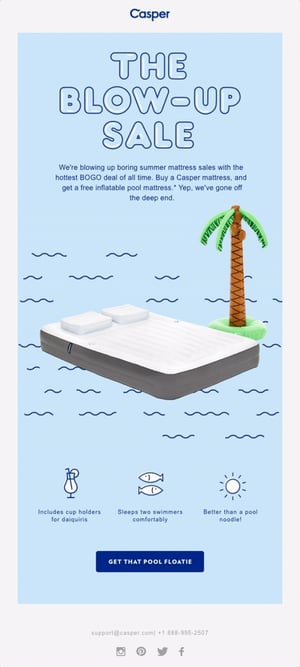
Source: Really Good Emails
Who said that seasonal sales are limited to New Year’s or Mother’s Day? Casper’s seasonal email takes advantage of summertime to offer its pool mattress as a gift for every mattress purchased.
That’s an excellent example of how to match the offer to the occasion and lure recipients in with a deal they can’t resist. Add that to witty copy and creative design, and you’ve got yourself a winning combo!
Transaction
Transactional emails are sent out when a lead interacts with your brand in a way you’ve previously set up. The interaction could be anything from subscribing to your newsletter to confirming an order.
Sending transactional emails allows you to transmit important information and builds customer loyalty. And bonus – transactional emails have increased open rates because your leads expect to get them. Always consider your timing because delays in dispatching them could result in losing potential customers.
Subject line: We got your order. (You have great taste!)
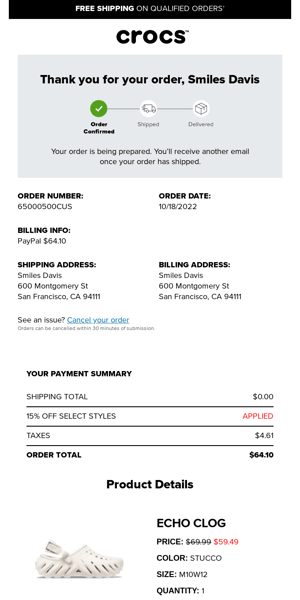
Source: Really Good Emails
As pointed out, transactional emails are built with the consumer in mind. In this transactional email example, Crocs includes all the necessary order details, as well as links to the FAQ section and an option to contact customer service in case of questions. Also, several CTAs lead recipients back to the company’s online store to keep browsing its products.
Personalized
Recipients demand personalized marketing. Personalizing pre-made email templates is crucial for building deep relationships and showing customers you care enough to tweak your email content to their needs.
Customized email content and offers constitute a reward for them. To show customers your appreciation, tailor your email according to the most relevant information at your disposal, such as geographical or behavioral data. You can also use your email service provider’s analytics to gain valuable insights into your recipients’ behavior, such as their browsing history.
Subject line: What to watch after The Queen’s Gambit
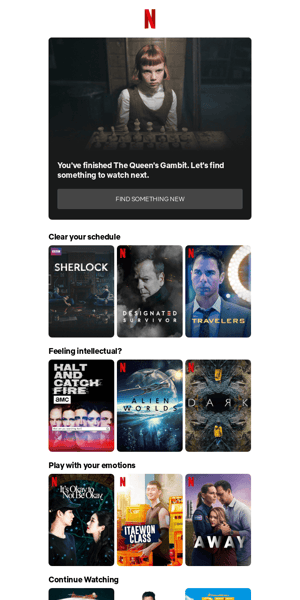
Source: Really Good Emails
Netflix certainly has the know-how to hook viewers and urge them to revisit for more. In this personalized email template, Netflix uses the recipient’s viewing history to provide customized recommendations. The recommendations are divided into different categories, including unfinished or previously watched programs
Re-engagement
Unfortunately, a percentage of your subscribers will disengage from your brand. But not every inactive recipient is uninterested in your value proposition, so don’t lose faith. Re-engaging inactive subscribers costs less than generating new ones and isn’t as intimidating as you think.
You could send gentle reminders to showcase how your product or service addresses its pain points or ask them for feedback to improve your performance. This email template is meant to grab their attention – now’s the time to get as creative as possible!
Subject line: Come on back – we made dinner easier! 😋

Source: Really Good Emails
Blue Apron’s re-engagement email is an excellent example of how to bring an inactive recipient back. Starting from the email subject line, the reader knows this email is about facilitating dinner. The email highlights the time and effort they’ll save by ordering while featuring an appealing image of a delicious meal. To further motivate the reader, the brand offers a $30 discount on the first two orders.
Feedback request
One of the marketing’s biggest mistakes is assuming the company knows what customers want. As a result, they miss the opportunity to hear it from the horse’s mouth and improve customer experience. To get feedback, include a survey in your email template and ask recipients to complete it.
Make the process easy and fast to avoid annoying them. Also, let them know you plan to use their insight to improve your offering as it hits a soft spot. Timing is of the essence with these emails.
Try to dispatch them after subscribers use a product or interact with your customer support department. You might even want to throw in incentives like discounts or entries in a giveaway contest to show them you appreciate their time.
Subject line: Take our survey to get 10% off your next Aero flight.
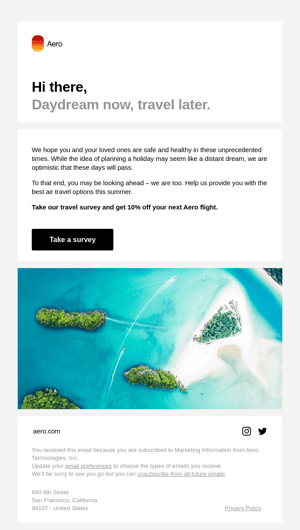
Source: Really Good Emails
Aero’s feedback request email template makes its objective clear from the concise subject line. Recipients know what’s in it for them before even opening it.
The email content itself is straightforward and centered around the specific action the brand expects recipients to take. In addition to that, they incentivize recipients by highlighting the discount they get once they complete the survey.
Creating effective email templates for a successful marketing strategy
Email templates are at the heart of every successful marketing strategy. Initially, it might seem like a lot of trouble, but you don’t have to reinvent the wheel.
With email templates, you achieve cohesive email marketing and build long-term relationships with recipients, even with limited resources, technical skills, or time. By following the best practices and taking inspiration from the best email templates, you’re on your way to sending your most engaging emails.
Take advantage of your email service providers to monitor your email template performance in terms of crucial metrics like open rates, unsubscribes, and click-through rates. These insights, along with any recipient data available and the feedback you receive from email surveys, will be your ally for building an optimized, data-driven content strategy.
Are you ready to create the most memorable email experiences for your customers? Learn more about personalized email campaigns and the surefire ways to nail them.


